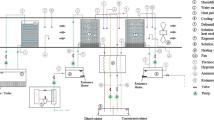Abstract
A two-layer model for a solid polymer electrolytic (SPE) dehumidifier is applied to a system in which the chamber to be dehumidified has some leakage area. By introducing this area, the attainable humidity in the chamber, which is the steady-state humidity to be attained after a long-time dehumidification, can be defined. Experimental results of dehumidification by an SPE dehumidifier are compared to the calculations based on the two-layer model for the SPE dehumidifier, which was presented in our previous paper. Equations for the two-layer model are simplified by making use of assumptions for the current characteristics and a constant environmental condition, and it is reduced to equations including a differential equation on the time variation of the humidity in the chamber. The differential equation to describe the attainable humidity in the chamber and time constant for the dehumidification is obtained. The current flowing in the dehumidifier under steady state conditions is also given as a function of the humidities in the spaces facing the anode and the cathode. A diagram to estimate the attainable humidity and the time required for dehumidification from the dehumidifying area and leakage area is also given.







Similar content being viewed by others
Abbreviations
- D :
-
Diffusion coefficient of water in the dehumidifying element (cm2 s−1)
- e :
-
Electron charge = 1.602 × 10−19 (C)
- I :
-
Current of the dehumidifying element (A)
- κ g :
-
Coefficient relevant to the diffusion velocity of water from the air to the SPE membrane (cm s−1)
- κ s :
-
Coefficient relevant to the diffusion velocity of water from the membrane to the air (cm s−1)
- L :
-
Thickness of the dehumidifying element (= 0.017 cm)
- N A :
-
Avogadro’s number = 6.02 × 1023 (mol−1)
- RH :
-
Relative humidity (%)
- R s :
-
Electrical resistance of the dehumidifying element (Ω)
- S :
-
Area of the dehumidifying element (cm2)
- Sℓ :
-
Equivalent leakage area with the rate constant kg of water transfer (cm2)
- t :
-
time (s)
- T g :
-
Temperature of the gas space surrounding the dehumidifying element (K)
- U s :
-
Voltage applied to the dehumidifying element (=3 V)
- V g,p , V g,n :
-
Volumes of the spaces facing the anode and the cathode (cm3), respectively
- α :
-
The average number of water molecules carried by a proton moving to the cathode
- ρ g , ρ s :
-
Water density in the air surrounding the dehumidifying element and water content of the element (g cm−3), respectively
- ρ g,p , ρ g,n :
-
Water density in the air facing the anode (positive electrode) and cathode (negative electrode) (g cm−3), respectively
- ρ s,p , ρ s,n :
-
Water contents in the anode half and the cathode half of the dehumidifying element defined by two-layer model of the dehumidifier (g cm−3)
- g :
-
Gas space
- n :
-
Negative electrode or cathode
- p :
-
Positive electrode or anode
- s :
-
Solid polymer electrolytic dehumidifying element
References
Zawodzinski TA, Derouin C, Radzinski S, Sherman RJ, Smith VT, Springer TE, Gottesfeld S (1993) J Electrochem Soc 140(4):1041
Anantaraman AV, Gardner CL (1996) J Electroanal Chem 414:115
Springer TE, Zawodzinski TA, Gottesfeld S (1991) J Electrochem Soc 138(8):2334
Yamauchi S, Sakuma S, Nakatani H, Mitsuda K (2000) Trans IEE Jpn 120-A(5):607
Sakuma S, Yamauchi S, Takai O (2009) J Appl Electrochem 39:815
Hinatsu JT, Mizuhara M, Takenaka H (1994) J Electrochem Soc 141(6):1493
Society of Polymer Science Japan (1972) Polymer and humidity, 242
Acknowledgments
The authors gratefully acknowledge the financial support from the Ryosai Technica Company. The authors also acknowledge Mr. Yasuda, Mr. Abe and Mr. Yamaguchi for their help with the experiments. One of the authors (S.S.) would like to thank Mr. A. Ohnuma, the former president of the Ryosai Technica Company for providing the opportunity to carry out this study. Helpful comments from the referees are gratefully acknowledged.
Author information
Authors and Affiliations
Corresponding author
Rights and permissions
About this article
Cite this article
Sakuma, S., Yamauchi, S. & Takai, O. Estimation of dehumidifying performance of solid polymer electrolytic dehumidifier for practical application. J Appl Electrochem 40, 2153–2160 (2010). https://doi.org/10.1007/s10800-010-0197-4
Received:
Accepted:
Published:
Issue Date:
DOI: https://doi.org/10.1007/s10800-010-0197-4




